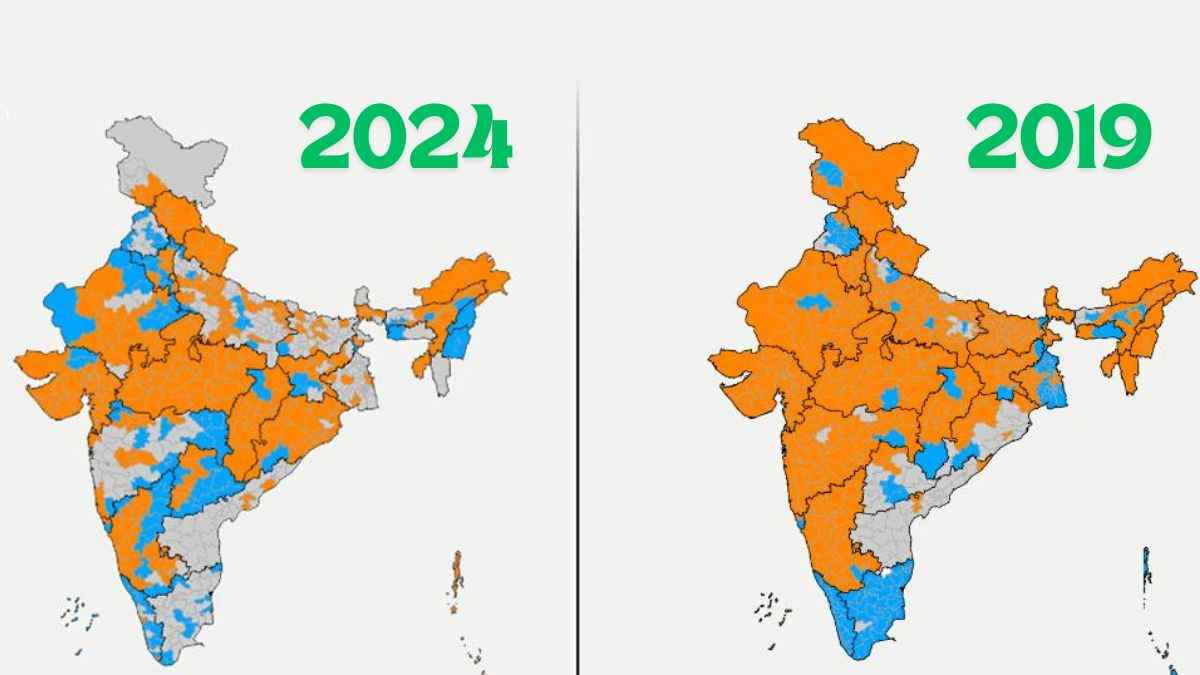The Lok Sabha elections in India are pivotal in shaping the nation's political landscape. Comparing the 2019 and 2024 election results reveals continuities and shifts in voter behaviour, party performance, and key issues. The exit polls have spoken, and the NDA looks set to repeat, if not exceed, its 2019 performance in the Lok Sabha Election 2024. While the results may be similar, the backdrop against which this election was held was quite different from the one in 2019. In the last election, the Shiv Sena won the 2019 polls in alliance with the BJP, but it is contesting this election as a split entity, with each of its two factions aligned with the rival BJP and the Congress party.

2019 vs 2024 Lok Sabha Election Results: Key Changes
The 2024 Lok Sabha Elections have made history by lasting 44 days and are declared the largest-ever polls since the 1952 India general elections. Here's an overview of what has changed and what has remained the same between these two significant elections.
-
Party Performance
- In 2019, the BJP, led by Prime Minister Narendra Modi, secured a decisive victory with 303 seats. In 2024, while the BJP maintained a strong presence, their seat count decreased slightly, reflecting a more competitive political environment.
- The INC showed a marginal improvement in 2024 compared to its performance in 2019, indicating a modest resurgence and better organisational strategies.
-
Emerging Parties and Alliances
- The influence of regional parties increased in 2024, with several new alliances forming and regional leaders gaining prominence.
- The emergence of a significant third front in 2024 highlighted the growing importance of regional politics and the fragmentation of traditional two-party dominance.
-
Voter Demographics and Turnout
- There was a noticeable increase in voter turnout in 2024, driven by targeted campaigns and social media engagement. As per the official data by ECI, the total count of voters in the Lok Sabha elections in 2024 will be 96.8 crores. Also, there were around 1.8 crore first-time voters and 19.47 crore voters between the ages of 20-29.
- Urban areas showed more varied voting patterns in 2024, reflecting diverse issues and candidate profiles, while rural areas focused on local leadership and agrarian issues.
- Till the 2019 Lok Sabha elections, the counting of postal ballots was taken up first and EVM counting began 30 minutes after that. Now, the Opposition-led INDIA bloc on Sunday had asked the poll body to issue directions to Returning Officers to ensure that postal ballots are counted and their results declared before the outcome of the EVMs is announced.
- The opposition leaders emphasized in a letter to the ECI that the Returning Officer must start the postal ballot counting procedure first, as stipulated by the Conduct of Election Rules, 1961. However, they claimed that this statutory practice was repealed and given a “go-by” by the poll body despite its 2019 guidelines to this effect.
-
Key Issues
- In 2024, economic issues such as unemployment and inflation took centre stage, influencing voter preferences more than in 2019.
- Social justice and environmental concerns gained more prominence in 2024, reflecting changing public priorities and global trends.
-
Gender Ratio
- As announced by the election commissioner of India, in 12 states, the female voter ratio will be higher than the male voter ratio in the Lok Sabha elections in 2024.
- In this Lok Sabha election, more than 85 lakh first-time female voters will be exercising their right to vote.
Continuities
-
Dominance of Major Parties
- The BJP and INC remained the principal players in the national political arena, continuing their roles as the leading national parties despite the rise of regional entities.
-
Modi Factor
- Prime Minister Narendra Modi's leadership and persona continued to be a significant influence in both elections, driving the BJP's campaign strategies and voter appeal.
-
Electoral Process and Technology
- The use of electronic voting machines (EVMs) and voter verified paper audit trails (VVPATs) ensured transparency and efficiency in both the 2019 and 2024 elections, maintaining public confidence in the electoral process.
-
Regional Issues and Caste Dynamics
- Regional issues and caste dynamics continued to play a crucial role in shaping electoral outcomes, with local leaders leveraging these factors to garner support.
The comparison between the 2019 and 2024 Lok Sabha election results highlights a dynamic political landscape characterized by both continuity and change. While major national parties like the BJP and INC maintained their dominance, the rise of regional parties and new voter priorities indicated an evolving electorate. The increasing participation of youth and the emphasis on economic and social issues in 2024 reflected a more engaged and diverse voter base. As India moves forward, these trends will likely continue to shape its democratic processes and political outcomes.
Also Check:
Comments
All Comments (0)
Join the conversation